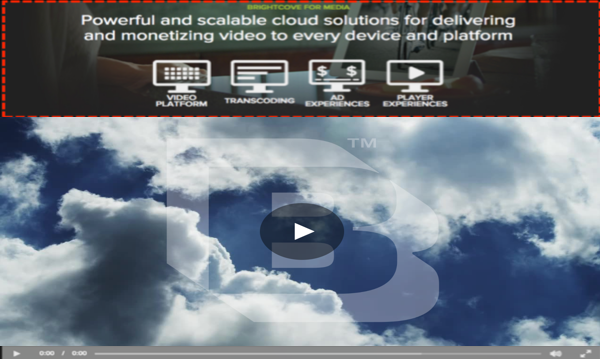Learning Guide: Video Advertising
Ad basics
In this section of the learning guide, basic concepts of video advertising are explained.
- Ad types
- Ad standards
- Ad pods
- Ad mime types
- Google's IMA SDKs
- Entities in video advertising
- Flash vs HTML
Ad types
There are three main types of video advertising, they are:
- Linear ads: Linear ads occur during playback of the video and are displayed in the player itself. The ad interrupts video playback either before (pre-roll), during (mid-roll) or after (post-roll) consumption of the video content by the user. The sample video below demonstrates the use of the IMA Plugin. Play the video to see a pre-roll, a skippable mid-roll at 5 seconds, then finally a post-roll.
- Non-linear ads: Non-linear ads run during playback so the users see the ad while viewing the content. Non-linear ads can be text, graphical ads or even video overlays. An example non-linear ad is a text overlay that displays over a playing video, but does not interrupt the video. The following example shows a screenshot of an overlay the user can click to go to another page. The overlay appears for some specified time, but does not interrupt playback of the video.

- Companion ads: Companion ads are text or display ads that appear around the video player, generally tied to the video content. An example companion ad is a banner that is tuned to video content. The following example shows a screenshot of the slot for the companion ad, marked by the dashed, red line, filled with a banner.

Ad standards
The Interactive Advertising Bureau (IAB) is an advertising business organization of more than 650 leading media and technology companies that develops industry standards, conducts research, and provides legal support for the online advertising industry.
The IAB Video Suite video does an excellent job explaining the whys and hows or their standards.
The following are key standards for video advertising:
- Video Multiple Ad Playlist (VMAP): Describes the prerolls, midrolls, postrolls, and non-linear ads for a video and when they should be shown.
- From IAB's standards: "The IAB Video Multiple Ad Playlist (VMAP) specification is an XML template that video content owners can use to describe the structure for ad inventory insertion when they don’t control the video player or the content distribution outlet."
- Video Ad Serving Template (VAST): VMAP says there is a pre-roll, VAST describes that pre-roll.
- From IAB's standards: "The Video Ad Serving Template (VAST) includes a standard XML-based ad response for in-stream video as well as an XML Schema Definition (“XSD”) for developers. It is meant to accommodate the majority of current practices within the online digital video advertising business."
- Video Player Ad-Serving Interface Definition (VPAID): VPAID is like VAST for interactive ads.
- VPAID: From IAB's standards" "The Video Player Ad-Serving Interface Definition (VPAID) establishes a common interface between video players and ad units, enabling a rich interactive in-stream ad experience."
- A simple VPAID example would be where a short intro video is displayed and if you mouse over More Info text a longer video would play.
- The VPAID format is commonly used by agencies and advertisers to run viewability scripts.
See IAB's website for complete documentation of standards.
Ad pods
New in VAST 3.x is the concept of an ad pod. An ad pod is the delivery of a set of sequential linear ads. The figure below represents an ad pod with three ads that play sequentially before normal video content. Ad Pods can play before, during a break in, or after the content video plays and function like a TV commercial break with multiple ad spots.

You can use VMAP to specify breaks for ad pods.
In the Ad Events and Ad Objects you see there are events concerning the playing of ad pods.
Ad mime types
All browsers that Brightcove supports will play MP4s. Our player implements cross-browser support for HLS and DASH (except in Safari, which natively supports HLS). Other formats will depend on the browser.
In general, we suggest MP4s for client-side advertisements. It's usually the most common.
Google's IMA SDKs
Google is a major player in video advertising and has defined the Google Interactive Media Ads (IMA) SDKs that enable publishers to display linear, non-linear, and companion ads in videos and games. The SDKs allow developers to make video ad requests to Google Ad Manager, the Google AdSense network, or any VAST-compliant ad server. The IMA3 plugin for Brightcove Player integrates Brightcove Player with Google's Interactive Media Ads (IMA) version 3 for HTML5 and Flash. This allows you to request and track ads for your Brightcove Player.
Some essential IMA terminology to understand follows:
- Ad rule: Defines when, where and how ads display with your video content. You can create ad rules to determine when ads play in a video or during a session (across multiple video streams), for how long, and as a result of which triggers. An ad rule is roughly similar to a VMAP document.
- Ad tag: Gives instruction to the browser to retrieve the ad from an ad server and what to do with the ad. The instructions will generate an ad request and there will be an appropriate response from an ad server. An ad tag is roughly similar to a VAST document.
For more information on IMA see Interactive Media Ads in Google's developer help section.
Entities in video advertising
Although many groupings of the entities involved in video advertising exist, a very simple example follows:
- Publishers - Have video content to show, and want to use ads to gain revenue.
- Advertisers - Have ads they want customers/potential customers to view.
- Ad networks - Match the publishers' ad space to advertisers' ads.
- Video Technology Providers - Provide encoding and player technologies to publishers and ad networks. Brightcove fits into the video technology providers group.
Flash vs. HTML
At this time Flash is giving way to HTML5 as the most frequently used ad format. For this reason it is recommended that the IMA3 plugin for Brightcove Player's adTechOrder option is set to html5 first, then flash. For more information see Flash No Longer Valid with IMA.
Ad workflow with Brightcove Player
The basic ad workflow when getting advertising to work with Brightcove Player is:
- Contact an ad provider. All advertising related Brightcove partners can be found in this search from the partners page. Those ad providers with Brightcove created plugins to support their ad technologies are Google's IMA3 technology and FreeWheel. A number of other ad providers have created their own plugins for Brightcove Player. The following table provides some detail on different ad providers and ad related technologies and how they relate to Brightcove Player. Provider/TechnologyIMA3 plugin.
Provider/Technology Comment DoubleClick (IMA3) Supported through IMA3 plugin. FreeWheel Supported through FreeWheel plugin SpotX A plugin is available from SpotX directly. See SpotX's Brightcove Plugin Integration documentation page. 3rd party VMAP (via IMA3 plugin) VMAP supports pre-rolls, mid-rolls, post-rolls and companions. 3rd party VAST3 (via IMA3 plugin) API is available to inject ads via VAST URL. VPAID 2 ads (via IMA3 plugin) Brightcove Player supports Javascript VPAID 2.0 ad units, which means it can be deployed without using Flash for any purpose across all devices. Use Server-Side Ad Insertion (SSAI). You can also use Brightcove's SSAI plugin to stitch ads into your video streams. This feature is enabled with Dynamic Delivery. For details, see the following documents:
- Verify your ad tag. Your ad provider will provide you with a URL you will supply Brightcove Player. It’s a good idea to make sure your ad tags are working before starting your player integration. If your ad provider uses standard VAST or VMAP ad responses, you can use Google’s Video Suite Inspector to quickly test if your ad tag is functioning. Some other vendors provide similar technology. Verifying the URL is not only a best practice at initial setup, but if issues occur later an excellent first step in troubleshooting ad playback would be to re-test the URL.
- Configure Brightcove Player with the vendor's information. After verifying the validity of the ad provider's URL, use the appropriate plugin to connect Brightcove Player to the ad server.
- Test the configuration. You will want to ensure ads are playing on all of your intended platforms, OSes and browsers. For instance, if your ad provider supplies only Flash ads, there could well be issues on iOS devices. Also, default desktop browser configurations can alter ad behavior.
Other documentation
Numerous other documents are available to help you with implementing ads with Brightcove Player. After this theoretical discussion in this document, a hands-on introduction may be a good next step. The Quick Start to Using Ads, detailed in the first bullet below, provides this hands-on experience. Also detailed below are the plugin documents.
Quick Start: Implementing Advertising| Document | Document Description |
|---|---|
| Step-by-Step: Implementing Advertising | A hands-on introduction to using the IMA3 plugin with Brightcove Player |
| Advertising with IMA3 | Document describing the functionality of the plugin, plus directions for implementation with Brightcove Player. |
| Advertising with FreeWheel | Document describing the functionality of the plugin, plus directions for implementation with Brightcove Player. |
| Advertising with SSAI | Document describing the functionality of the plugin, plus directions for implementation with Brightcove Player. |
| Using DFP Premium with Brightcove Player | A hands-on, lengthy guide to setting up GAM to integrate with Brightcove Player. |
Related Topics
Remember that the Brightcove advertising plugins implements standards, so the following documentation can greatly help in your usage of ads with Brightcove Player.
IAB
- Home page: https://www.iab.net/
- Video Advertising Introductory Video: https://www.iab.net/guidelines/508676/digitalvideo/vsuite
- VMAP standard: https://www.iab.net/guidelines/508676/digitalvideo/vsuite/vmap
- VAST 3 Standard: https://www.iab.net/guidelines/508676/digitalvideo/vsuite/vast
- VAST 4 Standard: https://www.iab.com/guidelines/digital-video-ad-serving-template-vast-4-0/
- VPAID Standard: https://www.iab.net/guidelines/508676/digitalvideo/vsuite/vpaid
- A Digital Video Advertising Overview (2008): https://www.iab.net/media/file/dv-report-v3.pdf
Google IMA SDKs
- Home Page: https://developers.google.com/interactive-media-ads/
- VAST Tag Validator: https://developers.google.com/interactive-media-ads/docs/sdks/html5/vastinspector
Ad Providers
- Google Ad Manager: Google Ad Manager Help Center
- FreeWheel Home Page: https://www.freewheel.tv/
- SpotX: Brightcove Plugin Integration
